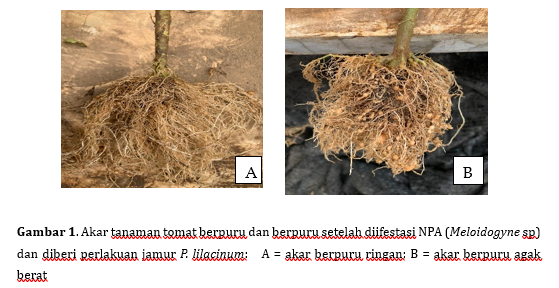Potensi jamur Purpureocillium lilacinum sebagai endofit pengendali nematoda puru akar pada tanaman tomat (Solanum lycopersicum L.)
##plugins.themes.bootstrap3.article.main##
Abstract
This research aims to study the effectiveness of the fungus Purpureocillium lillacinum as a control agent for root-knot nematodes and its potential as an endophyte in tomato plants. The study was conducted from August 2023 until Februaty 2024 in the greenhouse of the Integrated Field Laboratory, Faculty of Agriculture, University of Lampung. The experiment followed a Completely Randomized Design (CRD) consisting of five treatments with five replications. The treatments tested were different dosage levels of P. lilacinum fungus culture on rice; 5g, 10g, 20g, 20g, 40g and 0g per polybag containing 2.5 kg of planting medium. P. lilacinum was applied by spreading it on the planting medium and soaking the roots in a suspension of fungal conidia before transplanting. Seven days after transplanting, the tomato plants were infested with 2000 root-knot nematode (RKN) Meloidogyne sp. eggs. Ninety days after planting, the plants were harvested to observe nematode populations in the roots and soil, root damage, and fungal colonization in the roots. Nematode (J2) in roots were extracted using a modified Baerman method from 5g of root samples, while nematode (J2) in the soil were extraced by sieving and sentrifugation with a sugar solution from 300 cc of soil. Root damage was assessed using a root gall score 0-10, and fungal colonies in the roots was expressed as a percentage after staining using tryphan blue. Data were analyzed for variance and followed by the Least Significant Difference (LSD) test for at a 5% significance level. The results showed that the application P. lilacinum at 40 g per plant was effective in reducing root-knot nematode damage, as well as decreasing RKN (J2) populations in the soil and roots. Additionally, P. lilacinum was confirmed to be endophyte in tomato plants.
##plugins.themes.bootstrap3.article.details##

This work is licensed under a Creative Commons Attribution-NonCommercial 4.0 International License.
References
Arnold, A. E., dan Engelbrecht, B. M. 2007. Fungal endophytes nearly double minimum leaf conductanse in seedlings of a neotropical tree species. Journal of Tropical Ecology. 23(3): 369-372.
Diana, C. L., Keyan, Z, S., Maria, J, E., dan Gregory, A, S. 2014. The entomopathogenic fungal endophytes Purpureocillium lilacinum and Bauveria bassiana negatively affect cotton Aphid repeoduction under both greenhouse and field conditons. Journal Endhopytes. 9(8): 1-2.
Eisenback, J. D., and Triantaphyllou, H.H. 1991. Root-knot nematodes: Meloidogyne species and races. Pp. 191-274, In, W. R. Nickle, ed., Manual of Agricultural Nematology. Marcell Dekker: New York.
Fadji, E. A. dan Olubukola, O. B. 2020. Exploring the potentialities of benefical endophytes for improved plant growth. Journal Saudi biological science. 27(12): 3622-3633.
Fiandani, A., Swibawa, I, G., Fitriana, Y dan Poernomo. 2021. Pengaruh dosis bionematisida jamur Purpureocillium lilacinum (Syn. Paecilomyces lilacinus) isolate B01TG berbahan pembawa limbah pertanian terhadap keefektifannya dalam mengendalikan Meloidogyne sp. Jurnal Agrotek Tropika. 9(2): 189-197.
Khan, M dan Tanaka, K. 2023. Purpureocillium lilacinum for plant growth promotion andbiocontrol against root-knot nematodesinfecting eggplant. PLoS ONE 18(3): e0283550. https://doi. org/10.1371/journal.pone.028355
Kepenekci, I, Hazir, S, Oksal, E, dan Lewis E.E. 2028. Application methods of Steinernema feltiae, Xenorhabdus bovienii and Purpureocillium lilacinum to control root-knot nematodes in greenhouse tomato systems. Crop Protection 108: 31–38
Lenta, B. N., Jules, N., Marcel, F., Flora, L. Y., Steve, V., Flore, N. dan Carmela, M. 2016. Purpureone, an antileishmanial ergochromr from the endophytic fungus Purpureocillium lilacinum. Z. Naturforsch. 71(11) :1159-1167.
Seid, A., Fininsa, C., Mekete, T., Decraemer, W. Wesemael, V.M.L.2015. Toamto (Solanum lycopersicum) and root-knot-nematodes (Meloidogyne spp.)-a century-old-batle. Nemtology 17 (9): 995-1009.
Sheperd, R.L. and Huck, M.G. 1989. Progression of Root-knot Nematode Symptoms and Infection on Resistant and Susceptible Cottons. Journal of Nematology 21(2):235-241. .
Suharno., Retno, P, S., Endang, S, S., dan Rina Sri, K., 2014.Keberadaan fungi mikoriza Arbuskulas di kawasan tailing tambang emas timika sebagai upaya rehabilitasi ramah lingkungan. Jurnal Manusia dan Lingkungan.21(03):297-298.
Swibawa, I G., Fitriana, Y., Solikhin, Fiandani, A., Suharjo, R., Balqis, S., Purnomo, Susilo, F.X. 2024. Effectiveness of bionematicide from Purpureocillium lilacinum in controlling root knot nematodes (Meloidogyne spp.). J. Trp. Plant Pests Dis 24 (2) : 185-193.
Wilandari, R., Swibawa I G., Aeny, T.N. dan Purnomo. 2022. Efikasi bionematisida Purpureocillium lilacinum terhadap nematoda puru akar (Meloidogyne spp.) dari dua inang berbeda. Jurnal Agrotek Tropika, 10 (2): 187 – 193.
Zeck, W.M., 1971. A rating scheme for field evaluation of root-knot infestations. Pflanzenschutz-Nachr. Bayer AG 24, 141–144.

